By: Rob Mulder
For: www.europeanairlines.no
In the article “In the air with Roald Amundsen” we would like to introduce the readers to the kites, aircraft and airships the famous Norwegian explorer Roald Amundsen used for his expeditions during the first thirty years of the last century. Roald Amundsen purchased a number of aircraft and flying boats, but was also successful with a rigid airship of an Italian manufacturer.
Roald Amundsen (1872-1928)
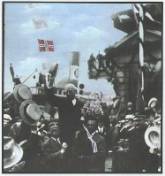 The first aviation event in Norway was the landing of a French air balloon in 1870. The Frenchmen Paul Rolier and Leon Bézier took off from the besieged city of Paris for what was supposed to be a short flight with mail. The encounter heavy winds and since the balloon could not be steered, they came off course and landed near Lifjell Mountain.
The first aviation event in Norway was the landing of a French air balloon in 1870. The Frenchmen Paul Rolier and Leon Bézier took off from the besieged city of Paris for what was supposed to be a short flight with mail. The encounter heavy winds and since the balloon could not be steered, they came off course and landed near Lifjell Mountain.
Two years later on July 16, 1872, the Norwegian explorer Roald Amundsen was born near Sarpsborg (Norway). His farther was a ship owner and sailed across the world. Two explorers inspired Roald Amundsen: The British Admiral Sir John Franklin (1) and the other one was Fridtjof Nansen – a leading figure in polar research. Fridtjof Nansen and his followers crossed the inland ice fields of Greenland in 1888. The trek took 42 days and temperatures reached –50° C. Fridtjof Nansen made another voyages, this time with the ship “Fram” (1893-1896) across the Arctic Ocean and this was followed by Otto Sverdrup’s mapping of the northwest coast of Greenland (1898-1902). His first encounter with the Antarctic was during the expedition of the Belgian sailing vessel “Belgica”. A lot has been written about his expeditions and we would like to give you the link to an interesting website (in English) about Roald Amundsen: www.south-pole.com/p0000101.htm.
In December 1911 Roald Amundsen reached the South Pole and this marked the end of an era. The next project was to explore the parts of the poles that were not yet explored. Was there more land on the North Pole? But how can we discover this in an easy way? It was clear that the upcoming of airships and aircraft in the beginning of the last century inspired Roald Amundsen. Due to lack of financial means it was decided to start exploring the use of a
Man-carrying kite (1909)
During the winter of 1908-09 Roald Amundsen was preparing the next polar expedition. He wanted to sail with the vessel “Fram” into the Bering Strait and get the ship to drift with the ice in northern direction. He hoped to end the journey between Greenland and Spitzbergen (2). Already in 1902 a German South Pole expedition had made use of a 300-m³ captive balloon for observations. Roald Amundsen felt that aircraft were still too fragile and balloons were too expensive. It was therefore decided to try kites. The use of man-carrying kites in general was not new. Already in 1894 the American Scouting General Baden-Powell had used kites and the Anglo-American Captain Samuel Franklin Cody (brother of the well-known American cowboy Buffalo Bill) sailed in 1903 across The Channel.
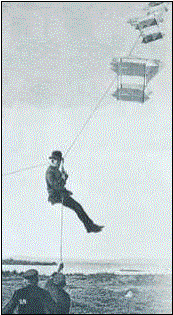 The first trials with kites in Norway started in the spring of 1909 at the island of Hovedøya in the Kristiania Fjord (now called Oslo Fjord). Captain Ole Engelstad led the attempts. The trials were successful and Captain Einar Sem-Jacobsen decided to build a better kite based on those used before. At the Navy’s ship yard at Horten the man-carrying kite was build. At the beginning of July 1909 the man-carrying kite was ready and taken to the small island of Vealøs for trials. The man-carrying kite consisted out of one 5 m² kite of 2-3 kg, four baring kites of 13 m², each weighing 7 kg and one 20 metres/12 kg man-carrying kite, that could lift up to 300 kg in the air. All kites were connected to each other by 8 mm and 1,000 long steel wire that weighed another 180 kg. Ten metres under the lowest kite was a small gondola for observation. The man-carrying kite could carry two 80 kg heavy men to 500 metres height. The trial flights with the man-carrying kites were done by Captain Einar Sem-Jacobsen, lieutenants Presterud, Opheim, Thommesen and sail constructor Rønne. After a tragic accident on July 26, 1909 all trial flights were halted. Lightning killed Captain Engelstad. During the trial the weather turned bad and dark clouds gathered above the island of Vealøs. The kite was at that moment at 500-600 metres height and it was decided to leave the kite rather than get electrified. The Captain Engelstad did not want to let the kite be destroyed, so he returned later to island to take down the kite. But there was too much electricity around the kite and he decided to leave it as it was. In stead he wanted to take along the kite that was already on the ground. But in stead he took the chance to lower the kite and was subsequently electrified and killed.
The first trials with kites in Norway started in the spring of 1909 at the island of Hovedøya in the Kristiania Fjord (now called Oslo Fjord). Captain Ole Engelstad led the attempts. The trials were successful and Captain Einar Sem-Jacobsen decided to build a better kite based on those used before. At the Navy’s ship yard at Horten the man-carrying kite was build. At the beginning of July 1909 the man-carrying kite was ready and taken to the small island of Vealøs for trials. The man-carrying kite consisted out of one 5 m² kite of 2-3 kg, four baring kites of 13 m², each weighing 7 kg and one 20 metres/12 kg man-carrying kite, that could lift up to 300 kg in the air. All kites were connected to each other by 8 mm and 1,000 long steel wire that weighed another 180 kg. Ten metres under the lowest kite was a small gondola for observation. The man-carrying kite could carry two 80 kg heavy men to 500 metres height. The trial flights with the man-carrying kites were done by Captain Einar Sem-Jacobsen, lieutenants Presterud, Opheim, Thommesen and sail constructor Rønne. After a tragic accident on July 26, 1909 all trial flights were halted. Lightning killed Captain Engelstad. During the trial the weather turned bad and dark clouds gathered above the island of Vealøs. The kite was at that moment at 500-600 metres height and it was decided to leave the kite rather than get electrified. The Captain Engelstad did not want to let the kite be destroyed, so he returned later to island to take down the kite. But there was too much electricity around the kite and he decided to leave it as it was. In stead he wanted to take along the kite that was already on the ground. But in stead he took the chance to lower the kite and was subsequently electrified and killed.
After the accident Roald Amundsen came down to Horten to follow the trials and everything was now finalized. At the beginning of September the man-carrying kite was packed for Roald Amundsen’s “Fram”-expedition. Despite the positive trials the kites were not used during the expedition.
Christoffersoin Flying Boat (1913-14)
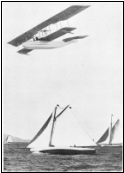 In 1913 Roald Amundsen left for the USA. He travelled around the country and held lectures about his polar explorations. During a visit in San Francisco, he met the Norwegian-American Johnsen, who took him in the air in the Christofferson Flying Boat. Amundsen was thrilled by the flying boat and bought two samples each costing 7,000 US Dollars. He believed that these flying boats were suitable for his Arctic flights. The hydroplane was suited for three passengers and had a 120hp Hall-Scott pusher engine. But the order had to be cancelled due to the high costs of transportation from San Francisco to Norway. Also the outbreak of the Great War in Europe made it impossible to fly with the flying boats.
In 1913 Roald Amundsen left for the USA. He travelled around the country and held lectures about his polar explorations. During a visit in San Francisco, he met the Norwegian-American Johnsen, who took him in the air in the Christofferson Flying Boat. Amundsen was thrilled by the flying boat and bought two samples each costing 7,000 US Dollars. He believed that these flying boats were suitable for his Arctic flights. The hydroplane was suited for three passengers and had a 120hp Hall-Scott pusher engine. But the order had to be cancelled due to the high costs of transportation from San Francisco to Norway. Also the outbreak of the Great War in Europe made it impossible to fly with the flying boats.
Farman Longhorn (1914)
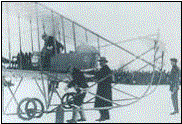 In 1914 Roald Amundsen could finally afford himself to buy an aircraft for arctic research. He and his friend Captain Einar Sem-Jacobsen had been in Paris and visited the Farman aeroplane factory. He understood that aircraft in general were not yet suited for solo flights to the Arctic and Antarctic areas, but it could well be used for flights from and back to the mother ship. He wanted to become a pilot and asked the Forsvarsdepartementet (the Norwegian Ministry of Defence) permission to start at the Army’s training school at Kjeller, just north of Kristiania (4). Permission was granted and in March 1914 he started to train with Captain Einar Sem-Jacobsen on an Army’s Farman. In June 1914 he passed his exam, smashing in the process the aircraft he was to use for his exam. But despite this mishap he passed and was awarded the first Norwegian pilot licence. The Pilot Licence Number 1 was handed out to him on September 18, 1915. Roald Amundsen ordered in 1914 a Farman aeroplane in France, but when the Great War broke out he donated it immediately to the Army.
In 1914 Roald Amundsen could finally afford himself to buy an aircraft for arctic research. He and his friend Captain Einar Sem-Jacobsen had been in Paris and visited the Farman aeroplane factory. He understood that aircraft in general were not yet suited for solo flights to the Arctic and Antarctic areas, but it could well be used for flights from and back to the mother ship. He wanted to become a pilot and asked the Forsvarsdepartementet (the Norwegian Ministry of Defence) permission to start at the Army’s training school at Kjeller, just north of Kristiania (4). Permission was granted and in March 1914 he started to train with Captain Einar Sem-Jacobsen on an Army’s Farman. In June 1914 he passed his exam, smashing in the process the aircraft he was to use for his exam. But despite this mishap he passed and was awarded the first Norwegian pilot licence. The Pilot Licence Number 1 was handed out to him on September 18, 1915. Roald Amundsen ordered in 1914 a Farman aeroplane in France, but when the Great War broke out he donated it immediately to the Army.
Curtiss Oriole (1922)
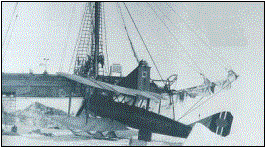 Early 1922 Roald Amundsen travelled again to the USA and decided to try to purchase aircraft good enough for Antarctic conditions. He purchased a Curtiss Oriole. This aircraft was regarded as “the first the Curtiss line of civil birds”. A 160 hp Curtiss C-6 engine powered it. Furthermore, it is known that similar aircraft were sold as low as $ 3,000 to compete with the war-surplus inundation (5). It was faster than any other plane of its power and carrying capacity and would be used for short reconnaissance flights from the vessel “Maud”. The non-registered aircraft carried the name “Kristine” (named after Kristine Elisabeth Bennet). It was equipped with skies and it seems that Glenn H Curtiss offered the aircraft to Roald Amundsen.
Early 1922 Roald Amundsen travelled again to the USA and decided to try to purchase aircraft good enough for Antarctic conditions. He purchased a Curtiss Oriole. This aircraft was regarded as “the first the Curtiss line of civil birds”. A 160 hp Curtiss C-6 engine powered it. Furthermore, it is known that similar aircraft were sold as low as $ 3,000 to compete with the war-surplus inundation (5). It was faster than any other plane of its power and carrying capacity and would be used for short reconnaissance flights from the vessel “Maud”. The non-registered aircraft carried the name “Kristine” (named after Kristine Elisabeth Bennet). It was equipped with skies and it seems that Glenn H Curtiss offered the aircraft to Roald Amundsen.
In 1922 the Curtiss Oriole “Kristine” had been in the air twice with Odd Dahl as pilot and Captain Wisting as observer. But during the landing after the second flight the aircraft was destroyed beyond repair.
Junkers-Larsen JL-6 (1922-23)
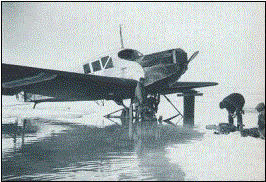 The Curtiss Oriole “Kristine” was to be used on shorter flights. The idea behind the purchase of the Junkers Larsen JL-6 was that Roald Amundsen believed it could be used for longer flights from the mother ship “Maud”. In the USA the Junkers Larsen JL-6 had proven itself on numerous long distance flights, among them one in October 1920 from New York to Los Angeles. In May 1921 a Junkers Larsen JL-6 with the American pilot Stinson at the controls made an endurance flight and stayed 26 hours and 19 minutes in the air. Therefore Roald Amundsen believed this aircraft would be ideal for his flights. He also believed that the duralumin would be ideal for Arctic and Antarctic conditions. The aircraft for Roald Amundsen was delivered in May 1922 in New York and the Norwegian pilot Oscar Omdal was asked to fly the aircraft. In order to get to know the aircraft Omdal flew the aircraft from New York to Seattle, i.e. from the east coast to the west coast. While flying above the oil fields of Pennsylvania (near the city of Marion) the engine stalled and the subsequent forced landing led to the total destruction of the aircraft. Immediately another Junkers Larsen JL-6 was purchased, but this time the aircraft was delivered in boxes to Seattle, where “Maud” had moored. The Junkers Larsen JL-6 and the Curtiss Oriole were taken on board and the ship departed in northern direction. Oscar Omdal and Roald Amundsen went ashore in Wainwright at Alaska’s northern coast. The Junkers-Larsen JL-6 was unloaded as well. The idea was to make a long distance flight in northern direction and try to come as far as possible. The new Junkers Larsen JL-6 was now named “Elisabeth” (as the Curtiss Oriole named after Kristine Elisabeth Bennet) and the cases with the aircraft were stored on land. But the summer and autumn of 1922 was marked with strong winds and storms making it impossible for the two to take off. They had to build a house and stay there during the winter. The next spring a new attempt would be made and the date June 20, 1923 was set.
The Curtiss Oriole “Kristine” was to be used on shorter flights. The idea behind the purchase of the Junkers Larsen JL-6 was that Roald Amundsen believed it could be used for longer flights from the mother ship “Maud”. In the USA the Junkers Larsen JL-6 had proven itself on numerous long distance flights, among them one in October 1920 from New York to Los Angeles. In May 1921 a Junkers Larsen JL-6 with the American pilot Stinson at the controls made an endurance flight and stayed 26 hours and 19 minutes in the air. Therefore Roald Amundsen believed this aircraft would be ideal for his flights. He also believed that the duralumin would be ideal for Arctic and Antarctic conditions. The aircraft for Roald Amundsen was delivered in May 1922 in New York and the Norwegian pilot Oscar Omdal was asked to fly the aircraft. In order to get to know the aircraft Omdal flew the aircraft from New York to Seattle, i.e. from the east coast to the west coast. While flying above the oil fields of Pennsylvania (near the city of Marion) the engine stalled and the subsequent forced landing led to the total destruction of the aircraft. Immediately another Junkers Larsen JL-6 was purchased, but this time the aircraft was delivered in boxes to Seattle, where “Maud” had moored. The Junkers Larsen JL-6 and the Curtiss Oriole were taken on board and the ship departed in northern direction. Oscar Omdal and Roald Amundsen went ashore in Wainwright at Alaska’s northern coast. The Junkers-Larsen JL-6 was unloaded as well. The idea was to make a long distance flight in northern direction and try to come as far as possible. The new Junkers Larsen JL-6 was now named “Elisabeth” (as the Curtiss Oriole named after Kristine Elisabeth Bennet) and the cases with the aircraft were stored on land. But the summer and autumn of 1922 was marked with strong winds and storms making it impossible for the two to take off. They had to build a house and stay there during the winter. The next spring a new attempt would be made and the date June 20, 1923 was set.
By May 1923 the aircraft was assembled again and ready for the first flight. On May 11, 1923 the first test flight was made. Amundsen wrote in his diary: “He approached the houses, losing altitude very quickly, and barely missing them. He ended up down on the lagoon, a few metres from where he had taken off. The left ski cut across under the engine, flipped a half circle and overturned on the right wing. Oskar Omdal was never in any danger. We all ran over to the aircraft. The landing gear that was fastened to the left ski was broken. Omdal said that the engine had been working very unsatisfactorily … After this, I have little hope of a flight.” They tried to do some repairs, but by June 10 it was clear that they had to give up and cancel the entire flight (6).
Jfa informed that the Junkers Larsen JL-6 had been an old aircraft and that the engine had not been reliable. The Consul Haakon H Hammer (the one that took care of the financial side of the expedition) offered on behalf of Junkers Flugzeugwerk AG – Jfa a new aircraft that Amundsen could use for a flight from Spitzbergen towards the North Pole and back. But Roald Amundsen was fed up with the problems with the Junkers-aircraft and declined the offer.
Since most pictures have copyright, we hereby give two links at the National Library in Norway, where some pictures of their stay in Wainwright can be seen: Elisabeth in Wainwright 1 and Elisabeth in Wainwright 2.
Dornier Delphin (1924)
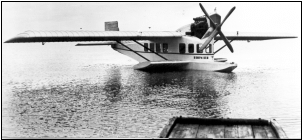 Spring 1924 Roald Amundsen came in contact with another famous German manufacturer: Claude Dornier. Roald Amundsen had told him about his plan to reach the North Pole by aircraft and he believed a flying boat was more suited than an aircraft with skies as undercarriage. Claude Dornier offered the Dornier Delphin, his latest product. Roald Amundsen wanted no less than four flying boats all equipped with an 185hp engine and additional fuel tanks. In this way the flight could be performed without too big risks. However, precise calculations revealed that the aircraft could not perform a flight from Spitzbergen to Alaska, as its range of 700 km was found too short. In stead, Amundsen cancelled the order and chanced it into Dornier Wal flying boats.
Spring 1924 Roald Amundsen came in contact with another famous German manufacturer: Claude Dornier. Roald Amundsen had told him about his plan to reach the North Pole by aircraft and he believed a flying boat was more suited than an aircraft with skies as undercarriage. Claude Dornier offered the Dornier Delphin, his latest product. Roald Amundsen wanted no less than four flying boats all equipped with an 185hp engine and additional fuel tanks. In this way the flight could be performed without too big risks. However, precise calculations revealed that the aircraft could not perform a flight from Spitzbergen to Alaska, as its range of 700 km was found too short. In stead, Amundsen cancelled the order and chanced it into Dornier Wal flying boats.
Dornier Wal (1924-25)
The original plane was to purchase two Dornier Wal flying boats with each two 380hp Rolls Royce engines. The range of these aircraft was twice as much as the Dornier Delphin. But soon this plan was skipped in favour of three Dornier Wals. All three would fly towards the North Pole, but here they would land, pump over the petrol from the third to the other two ‘boats and the two would continue to Alaska. The third aircraft would be abandoned at the North Pole. The aircraft were expected to be ready in May 1924 and in Norway the registrations N-24, N-25 and N-26 were reserved for the three Dornier Wals. The last aircraft (N-26, ex I-DEOR, c/n 19) was supposed to be a gift of the Italian dictator Mussolini under condition that the Italian pilot Antonio Locatelli (1895-1936) would be allowed to join the expedition. The registration N-26 was cancelled, possibly because the Italians wanted the aircraft to fly with an Italian registration. The other two aircraft were not delivered due to problems with the financing of the flying boats. Mussolini suggested that Antonio Locatelli would make the flight across the North Pole alone with the Dornier Wal, I-DEOR, but this plan was not carried out either.
In September 1924, Roald Amundsen returned to Kristiania and walked into the office of the Norsk Luftseiladsforening (the predecessor of the Norwegian Aero Club), where he had a meeting with the chairman, Dr Rolf Thommessen. He suggested that the two would work together and try to collect money for the purchase of the two flying boats. The aero club welcomed the idea and the search for funds started.
Meanwhile, Roald Amundsen travelled to the USA again to earn some money on his lectures. But during his stay in the USA a telephone call from Lincoln Ellsworth made him the happiest man alive. Lincoln Ellsworth was interested in funding the expedition and on March 11, 1925 a limited company was formed that would administrate the whole expedition. The name of the company was “Norsk Luftseiladsforening A/S for Amundsen-Ellsworths Polflyvning 1925” and it was registered on May 6 that year. The money received from Lincoln Ellsworth made it possible to buy the two Dornier Wals. In January 1925 the flying boats were test flown in Pisa (Italy) and subsequently dismantled for transportation to Spitzbergen. As pilots Hjalmar Riiser-Larsen and Leif Dietrichson were engaged, while Oskar Omdal and the German Karl Feucht were hired as mechanics. In addition Roald Amundsen would lead the N-25 and Lincoln Ellsworth the N-24.
There has been a long discussion whether Roald Amundsen wanted to fly to the North Pole and back or fly from Spitzbergen to Alaska. His original, and for most secret, plan was to fly from Spitzbergen to Alaska and not to be the first to reach the North Pole. Also, a flight to and from the North Pole would not be possible with the Dornier Wal. Furthermore, Roald Amundsen was also not the man to think about “being the first”.
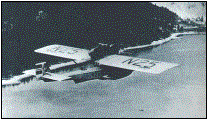 On May 21, 1925 the two flying boats were assembled and ready for take-off. They took off from the frozen Kongsfjorden (in English known as Kings Bay) and started flying north. After eight hours of flight and well above the ice they decided to land on the ice to get an exact position. It turned out that they were at 87º 43’ North, 251 kilometres from the North Pole. But the N-24 was damaged during the landing and the crew had to crawl through the ice to the Dornier Wal N-25. In a common effort the two crews build a runway using primitive tools and fighting against the elements. Moving ice destroyed several times the runway and they had to start all over again. Eventually, after emptying the flying boat for all unnecessary material, the six men boarded the Dornier Wal, N-25. On June 15, 1925 Hjalmar Riiser-Larsen managed to lift the flying boat off the ice and fly back to Nordaustlandet, where they landed safely. A small vessel, called “Sjøliv” transported the crew to Kongsfjorden, where the arrived on June 18. Of course, Amundsen was disappointed and could not quite understand the fantastic reception they received when they returned to Oslo on July 5. They were met by the whole population of Oslo and given a royal banquet at the Royal Palace.
On May 21, 1925 the two flying boats were assembled and ready for take-off. They took off from the frozen Kongsfjorden (in English known as Kings Bay) and started flying north. After eight hours of flight and well above the ice they decided to land on the ice to get an exact position. It turned out that they were at 87º 43’ North, 251 kilometres from the North Pole. But the N-24 was damaged during the landing and the crew had to crawl through the ice to the Dornier Wal N-25. In a common effort the two crews build a runway using primitive tools and fighting against the elements. Moving ice destroyed several times the runway and they had to start all over again. Eventually, after emptying the flying boat for all unnecessary material, the six men boarded the Dornier Wal, N-25. On June 15, 1925 Hjalmar Riiser-Larsen managed to lift the flying boat off the ice and fly back to Nordaustlandet, where they landed safely. A small vessel, called “Sjøliv” transported the crew to Kongsfjorden, where the arrived on June 18. Of course, Amundsen was disappointed and could not quite understand the fantastic reception they received when they returned to Oslo on July 5. They were met by the whole population of Oslo and given a royal banquet at the Royal Palace.
At first, the aircraft N-25 was stored and in March 1927 used for some trial flights between Norway and England, before it was sold to Frank Courtney (in England) as G-EBQO. It was later bought by Dornier Metallbauten GmbH and registered as D-1422.
Since most pictures have copyright, we hereby give two links at the National Library in Norway, where some pictures of their flight towards the North Pole can be seen: Roald Amundsen’s Dornier Wal. Press “neste liste” to see more pictures. By pressing on other blue links you can go even deeper into the archive with pictures and see even more pictures. Nearly endless and very interesting as many pictures have been coloured as well!
Rigid airship N-1
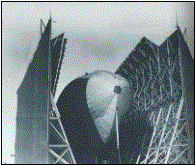 After the use of flying boats did not work out as planned, Roald Amundsen wanted to make a new flight with a rigid airship. The advantage of the air ship was that it had a higher payload than flying boats and could stay longer in the air. The ship chosen was the Italian build N.1. The designer Umberto Nobile had built it in 1924 and the ship had a length of 106 metres, a wide of 19.6 metres and contained 19,500 m³ of hydrogen. It had three 245hp Maybach engines. On March 29, 1926 the ship was handed over during a ceremony in Roma and in April it left the eternal city for the flight to Spitzbergen. On its way it passed Pulham (England), Oslo, Leningrad and Vadsø. It arrived Ny-Ålesund (formerly known as Kings Bay) on May 7, 1926. A huge, wooden airship hangar had been erected and the airship was housed here. The ship now carried the Norwegian registration N-1 and the name “Norge” (Norway).
After the use of flying boats did not work out as planned, Roald Amundsen wanted to make a new flight with a rigid airship. The advantage of the air ship was that it had a higher payload than flying boats and could stay longer in the air. The ship chosen was the Italian build N.1. The designer Umberto Nobile had built it in 1924 and the ship had a length of 106 metres, a wide of 19.6 metres and contained 19,500 m³ of hydrogen. It had three 245hp Maybach engines. On March 29, 1926 the ship was handed over during a ceremony in Roma and in April it left the eternal city for the flight to Spitzbergen. On its way it passed Pulham (England), Oslo, Leningrad and Vadsø. It arrived Ny-Ålesund (formerly known as Kings Bay) on May 7, 1926. A huge, wooden airship hangar had been erected and the airship was housed here. The ship now carried the Norwegian registration N-1 and the name “Norge” (Norway).
Prior to the arrival of “Norge” the American navy captain Richard E Byrd’s aircraft arrived by ship in Ny-Ålesund. It was a Fokker F.VII called “Josephine Ford”. He intended to make a flight from Ny-Ålesund to the North Pole and back, but on his first attempt the aircraft had an accident that damaged the undercarriage. Roald Amundsen allowed Bernt Balchen (who had joined Roald Amundsen as reserve pilot) to make better skies and on May 9 the Fokker F.VII flew towards the North Pole. 15½ hours later Byrd returned and was greeted by Amundsen and his crew. He had managed to fly to the North Pole and return safely. Upon his return the respected Norwegian journalist Odd Arnesen had doubt about the achievement of Byrd and Bennett. Bernt Balchen had calculated “…The distance from Kings Bay to the North Pole is 1,235 kilometres. The return trip from Kings Bay to the North Pole, a distance of 2,470 kilometres, would have taken the Fokker 21.9 hours if we assume that it maintained a speed of 112 km/h”. But for the time being the two were regarded as the first to have reached the North Pole. Later it turned out that Byrd and Bennett had not been honest about their achievement.
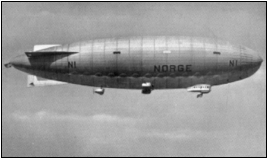 Meanwhile, the airship N-1 “Norge” was ready for its flight. Roald Amundsen’s main objective of the flight was to cross the Arctic Ocean and discover the massive drift ice around the North Pole. To find new land was regarded as not likely. On May 11 the airship finally took off with a crew of sixteen. The airship made a calm and non-dramatic flight across the North Pole. When they reached the geographical North Pole on May 12 at 2.20 am Lincoln Ellsworth could celebrate his birthday. The flags of Italy, Norway and the USA were dropped and the airship continued on its trip towards Alaska. They landed at Teller, Alaska, USA and immediately the airship was packed down and taken apart for transportation back to Europe. The flight had a rather nasty aftermath as General Umberto Nobile claimed that the expedition was Italian. This enmity had started a long time before the flight. The Italian side and the Norwegian-American side separated in anger. Roald Amundsen claimed that he and Ellsworth were the leaders of the expedition, but we must not forget that the airship had been a save way of transportation and no accidents or incidents had occurred during the whole flight. Nobile played an important rôle in the accomplishment of the flight. But Roald Amundsen would come to the saviour when General Umberto Nobile and his airship “Italia” had to make a forced landing on the Arctic ice in 1928.
Meanwhile, the airship N-1 “Norge” was ready for its flight. Roald Amundsen’s main objective of the flight was to cross the Arctic Ocean and discover the massive drift ice around the North Pole. To find new land was regarded as not likely. On May 11 the airship finally took off with a crew of sixteen. The airship made a calm and non-dramatic flight across the North Pole. When they reached the geographical North Pole on May 12 at 2.20 am Lincoln Ellsworth could celebrate his birthday. The flags of Italy, Norway and the USA were dropped and the airship continued on its trip towards Alaska. They landed at Teller, Alaska, USA and immediately the airship was packed down and taken apart for transportation back to Europe. The flight had a rather nasty aftermath as General Umberto Nobile claimed that the expedition was Italian. This enmity had started a long time before the flight. The Italian side and the Norwegian-American side separated in anger. Roald Amundsen claimed that he and Ellsworth were the leaders of the expedition, but we must not forget that the airship had been a save way of transportation and no accidents or incidents had occurred during the whole flight. Nobile played an important rôle in the accomplishment of the flight. But Roald Amundsen would come to the saviour when General Umberto Nobile and his airship “Italia” had to make a forced landing on the Arctic ice in 1928.
The death of Roald Amundsen
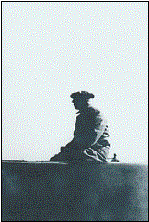 On the May 23, 1928, the Italian airship “Italia” departed from Svalbard and it arrived on the North Pole on the 24th. of June, but it crashed on its way back. Six men from the crew disappeared with the Zeppelin, and from the ten people in the gondola, one died, and three were injured. A large scaled rescue operation was launched. The operation involved 23 airplanes, 16 ships and approximately 1400 men. The operation lasted from May, 26 until October 16, 1928. During the rescue operation, 17 people were killed. This search and rescue operation was one of the biggest media events of the 1920’s.
On the May 23, 1928, the Italian airship “Italia” departed from Svalbard and it arrived on the North Pole on the 24th. of June, but it crashed on its way back. Six men from the crew disappeared with the Zeppelin, and from the ten people in the gondola, one died, and three were injured. A large scaled rescue operation was launched. The operation involved 23 airplanes, 16 ships and approximately 1400 men. The operation lasted from May, 26 until October 16, 1928. During the rescue operation, 17 people were killed. This search and rescue operation was one of the biggest media events of the 1920’s.
When “Italia” disappeared in the Arctic, Roald Amundsen was asked to lead a French rescue operation using the airplane “Latham”, constructed to take off and land on the sea. The flying boat left Tromsø June 18, 1928 at 16.00. At 18.45 the same day the last message was received. But with the similar type of aircrafts, N24 and N25, Roald Amundsen had been missing for 26 days. Therefore there was little worrying initially.
The day after, on the June 19, the crew of the “Italia” was found. The continued rescue operation was concentrated on recovering the Latham 47 and Roald Amundsen and the crew. Unfortunately, it was too late. Roald Amundsen and the rest of the crew had died in their effort to try and save others in peril.
Short list of the aircraft, rigid airships and flying boats used:
| Type | Registration | c/n | Name | Ordered | Delivered | Fate |
| Christoffersen Flying Boat | – | ? | – | Apr 1913 | No | |
| Christoffersen Flying Boat | – | ? | – | Apr 1913 | No | |
| Farman Longhorn | – | ? | – | 1914 | Yes | But handed over to Hærens Flyvevåpen |
| Curtiss Olione | – | ? | Kristine | 1922 | May 1922 | Made two flights and crashed |
| Junkers Larsen JL-6 | – | ? | Elisabeth | 1922 | Apr 1922 | Crashed at Marion (Pennsylvania) |
| Junkers Larsen JL-6 | – | ? | Elisabeth | 1922 | Jun 1922 | Crashed 1923 near Wainwright (Alaska) |
| Dornier Delphin | – | ? | – | 1924 | No | Found to have too small range |
| Dornier Delphin | – | ? | – | 1924 | No | Found to have too small range |
| Dornier Delphin | – | ? | – | 1924 | No | Found to have too small range |
| Dornier Delphin | – | ? | – | 1924 | No | Found to have too small range |
| Dornier Wal | N-24 | 1924 | No | Not taken up due to lack of money | ||
| Dornier Wal | N-25 | 1924 | No | Not taken up due to lack of money | ||
| Dornier Wal | N-26 | 19 | 1924 | 25 Jul 1924 | Present from Mussolini | |
| Dornier Wal | N-24 | 36 | 21 Nov 1924 | Jan 1925 | Used on Polar Flight | |
| Dornier Wal | N-25 | 37 | 21 Nov 1924 | Jan 1925 | Used on Polar Flight | |
| Nobile N.1 | N-1 | – | Norge | 1 Sep 1925 | 29 Mar 1926 | Used on flight across the North Pole |
Notes:
(1) Admiral Sir John Franklin perished together with a crew of 134 men in an attempt to sail through the Northwest Passage in the 1840’s.
(2) Spitzbergen became in the Twenties of the last century Norwegian territory. In Norway the area is known under the Norwegian name Svalbard.
(3) One was eventually sold to Japan. Others were used for sightseeing flights at the Panama-Pacific Exposition in San Francisco, and for Christofferson's San Francisco-Oakland aerial ferry in 1914 as the second commercial airline in the US. Company field, in 1913 at the foot of Sloat Blvd, was San Francisco's first airport, with a runway comprised of flat boards laid out on the beach. (Information from the website: www.aerofiles.com/chrisferry.jpg)
(4) From 1624 to 1925 Oslo was named Kristiania.
(5) See www.aerofiles.com/_curtx.html
(6) Passage from the book “Den Hvite Ørnen White Eagle” by Olav Gynnild.
Knut Erik Hagen has supplied most of the pictures.
